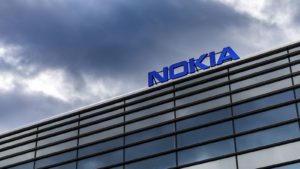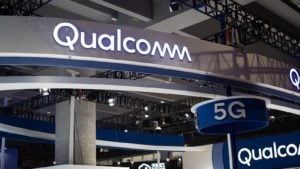Amidst growing global tumult, volatility has had the stock market swinging from extreme bearishness to brief moments of bullishness. And although the general direction is down, sticking to the game plan will pay off in the long run. Investors ought to stake claims in ongoing trends now to maximize returns over the next few years.
If anything, a market correction, or even a crash, can create better prices for investors willing to buy and hold. In the technology sector, the increasingly connected world of smart devices (speakers, thermostats and doorbells, to name just a few) will result in strong sales growth for these devices and the systems that power them. While consumers are familiar with these devices as ways to make life more convenient, turning on lights or opening garages with their smartphones, the business applications should appeal to investors.
Of course, this connected world needs communication infrastructure to support 5G networks and the Internet of Things (IoT). So, should the global economy slow considerably in the short-term, the demand for connectivity will not change much. For example, the sudden need to stay at home to work will increase the demand for connectivity solutions.
But these developments in the telecom sector are only one aspect of the increasingly connected world.
Robert Siegel, lecturer in management at Stanford Graduate School of Business, thinks every industry will be affected by the proliferation of smart devices that can communicate with each other via the internet:
“Some obvious ones include manufacturing, mobility, and healthcare. The ability to make things with speed and scale will drive large scale but simultaneously customized manufacturing of items ranging from clothing to retail to food (yes, food!). Cars will become moving collections of sensors which will impact traffic, entertainment (in and out of the vehicle) and hospitality.”
When it comes to the world of smart devices investors should invest not only in the “usual suspects” (telecom and tech stocks), but in companies that offer solutions in the automotive or retail space as well. Here are seven stocks investors should consider.
Tech Stocks to Buy: Cisco Systems (CSCO)

Cisco Systems (NASDAQ:CSCO) directly benefits from the surge of people working from home in order to minimize the spread of the coronavirus. Cisco CEO Chuck Robbins said that user activity for its video conference platform, WebEx, surged to 5.5 billion meeting minutes in just the first 11 days of March.
In the cloud space, Cisco has partnered with Amazon.com (NASDAQ:AMZN) and Microsoft (NASDAQ:MSFT) to support AWS and Azure, respectively. Its software-defined network (SDN) WAN connectivity gives those platforms very tight security, as well as a way to analyze the entire network of devices. On a conference call, Cisco said that its SDN provides data on “hundreds or thousands [of] different types of network devices.” That ensures the customer gets the most data out of its infrastructure.
Cisco has expertise in building large-scale networks that are highly available (e.g. reliable) and secure. Customers get better tools to manage the network and to ensure its security. In effect, Cisco enables users to connect quickly to an Azure or AWS platform.
Critically, Cisco has a security stack in place to handle a higher volume of users. So the end-user on, say, Office 365, should still have a good experience despite increased traffic.
That’s great news for Cisco. In a 5-year discounted cash flow growth exit model, assume revenue growing a modest 1.2% compounded annually. With the following metrics below, Cisco stock is worth over $50:
| Metrics | Range | Conclusion |
| Discount Rate | 9.5% – 8.5% | 9.00% |
| Perpetuity Growth Rate | 2.0% – 3.0% | 2.50% |
| Fair Value | $45.64 – $59.05 | $51.32 |
Data courtesy of finbox.io
AT&T (T)

AT&T (NYSE:T) is one of the best plays in the telecom sector right now, even if the company recently cancelled an accelerated share buyback to preserve cash on hand.
The company said that it decided to pause its $4 billion stock buyback “to maintain flexibility and focus on continued investment in serving our customers, taking care of our employees and enhancing our network, including nationwide 5G. These continued investments will help ensure the Company is well-positioned when the pandemic passes and economies begin to recover.”
Earlier in March 2020, the company announced that 5G is now live in 22 more markets across the U.S. Since some of the latest smartphones, like Samsung’s Galaxy S20, support 5G, customers will begin to utilize the faster low-band spectrum. 5G offers faster speeds over broader distances than the older 4G+ network. And since the demand for better network performance keeps growing, AT&T is in a good position to build its subscriber base at the expense of its competitors.
AT&T’s Business Solutions division sells wireless products, IoT, and connected devices through FirstNet. It is deploying high-speed nationwide wireless broadband to serve public safety. The reliability and speed of its network will serve to improve AT&T’s reputation. Consumer and business customers will switch to AT&T’s network if they want a better network and more services. AT&T said its Business Wireline group contributes a lot to its EBITDA.
Analysts currently have an average price target of $42.10 on AT&T stock (per Tipranks).
Nokia (NOK)

Nokia (NYSE:NOK) is a leading supplier of 5G networking solutions. In early March, the company announced a collaboration with Intel (NASDAQ:INTC). Nokia will ship variants of its 5G AirScale radio access solutions. This will embed Intel’s Atom P5900 processor. So, the 5G radio will “combine compute, connectivity, and acceleration technologies.” Because 5G supports billions of devices, the increase in volume and scale will need better technologies to back that demand.
Nokia entered a partnership with Marvell (NASDAQ:MRVL) to develop 5G multi-Radio Access Technology (multi-RAT). This will combine Nokia’s wireless technology with Marvell’s multi-core ARM processor platforms. Nokia’s ReefShark will benefit from lower power usage and smaller chip size.
Nokia is progressing well in the 5G space. In Feb. 2020, the company completed a 5G core standalone network trial with KDDI, a leading telecoms company in Japan. So Nokia, through its 5G AirGile cloud-native core product, has the know-how to analyze 5G networks in a stand-alone service format.
Assuming the following metrics in an earnings power value model, Nokia stock is worth $5.10:
| Metrics | Range | Conclusion |
| Adjusted Earnings | 952 M – 4.03 B | 1.988 B |
| Discount Rate | 9.0% – 7.0% | 8.00% |
| Fair Value | $2.39 – $11.31 | $5.10 |
Data courtesy of finbox.io
Ericsson (ERIC)

Just as Nokia reported a successful trial with KDDI, Ericsson (NASDAQ:ERIC) achieved cloud-native CI/CD (Continuous Integration/Continuous Delivery) pipeline delivery for KDDI’s standalone 5G Core network.
This will support the automatic deployment of new software and functions without disrupting the 5G core network. Ericsson has effectively automated the deployment process by taking out the need for staff involvement.
The company further announced the production of its first 5G base station. The factory is located in Lewisville, Texas. And once it is operational later this year, the factory will supply all radio access components for a solution that 5G networks will use.
In its fourth quarter, Ericsson management said it had nearly 80 commercial 5G agreements in place, with 24 5G networks already live. Customers are migrating to 5G and will need both operational support systems and cloud infrastructure as a by-product. So overall, gross margins held a steady 38.1%. The company’s portfolio will benefit from the good momentum regardless of the current market conditions.
Looking ahead, the shift from 4G to 5G is driving capital expenditure growth in the industry. Alongside that upgrade is data growth from users. Plus, the sudden shift in users needing to work remotely due to the COVID-19 lockdown also accelerated the upgrade timetable.
ERIC stock has a fair value of $7.94, according to a quantitative research report by Stock Rover.
NXP Semiconductor (NXPI)

NXP Semiconductor (NASDAQ:NXPI) beat consensus estimates yet again in the fourth quarter. The company benefited from strong demand in mobile, automotive, and industrial IoT markets. Revenue topped $2.3 billion, $30 million above company guidance.
In the industrial IoT sector, NXP posted revenue falling 12% year-on-year due to the U.S./China trade worries. But looking ahead, revenue from industrial IoT will rise by 20%. Mobile will increase in the low double-digit percentage range.
To bolster its Wi-Fi product, NXP acquired Marvell’s (NASDAQ:MRVL) connectivity business. This will strengthen its automotive infotainment connectivity solution. Its industrial and IoT applications will also benefit from the Marvell acquisition. In the 2021-22 period, NXP expects improved traction for its ultra-band solution. So, with more IoT application use cases, expect a higher revenue range forecast.
Management expects modest growth in the 5G space. On the conference call, CEO Rick Clemmer said that the company hasn’t “seen a resumption of the 5G growth yet. And it looks like it’ll still be a couple of quarters out before we’ll see strong growth in 5G deployment. We clearly see that it’s coming. Just don’t see it in the near term.”
STMicroelectronics (STM)

STMicroelectronics (NYSE:STM) has lost half its value on the stock market. The company said it will cut production by up to 50% due to the coronavirus outbreak in France. Yet if the global slowdown proves short-lived, STMicro should meet its full-year 2020 outlook. It commented on its conference call that product demand will grow because of trends in “smart mobility, power and energy applications, and IoT and 5G.”
STMicro set a $1.5 billion capital expenditure plan to support growth in those markets. Its eventual goal is $12 billion in revenue. If history is any indicator, this firm will exceed those targets. Last year, for example, demand in personal electronics such as smartphones and wearables, climbed in the latter half of 2019.
This year, 5G infrastructure build-outs are growing. So, ST is in a good position to meet the rising demand in IoT and 5G. And as more smartphone makers refresh the models to the 5G standard, the average selling price increases. ST will also offer such features as wireless charging and Micro Electro Mechanical Systems sensors.
On Wall Street, the average price target on STM stock is $28.98 (per Tipranks).
Qualcomm (QCOM)

Qualcomm (NASDAQ:QCOM) is a Wall Street favorite, with a $94.67 price target. The smartphone chip processor and modem supplier said that demand in China already returned to normal levels. The company is at the forefront of the 4G to 5G transition. In anticipation of the explosive growth ahead, the company is maintaining a healthy level of operating expenditure levels. This will help it keep or improve its structure.
In the long-term, investments in the business today will pay off tomorrow. With its radio frequency design wins and high-performance Snapdragon chip, investors should expect Qualcomm’s operating margins to increase. The business is so healthy not just in China but overall. The company said on its Q! earnings call that “in terms of inventory on 5G, we’re really at the front end. And we have increasing demand from our OEM base. And really, the challenge for us is how do we keep up with increasing demand, because it’s an incredible opportunity for us to grow.”
Investors may forecast revenue growing by around 3% annually in a 10-year discounted cash flow revenue exit model. Also, assume the following metrics:
| Metrics | Range | Conclusion |
| Discount Rate | 10.0% – 9.0% | 9.50% |
| Terminal Revenue Multiple | 3.4x – 4.4x | 3.9x |
| Fair Value | $74.34 – 92.15 | $82.92 |
Data courtesy of finbox.io
Disclosure: the author owns Nokia stock.
